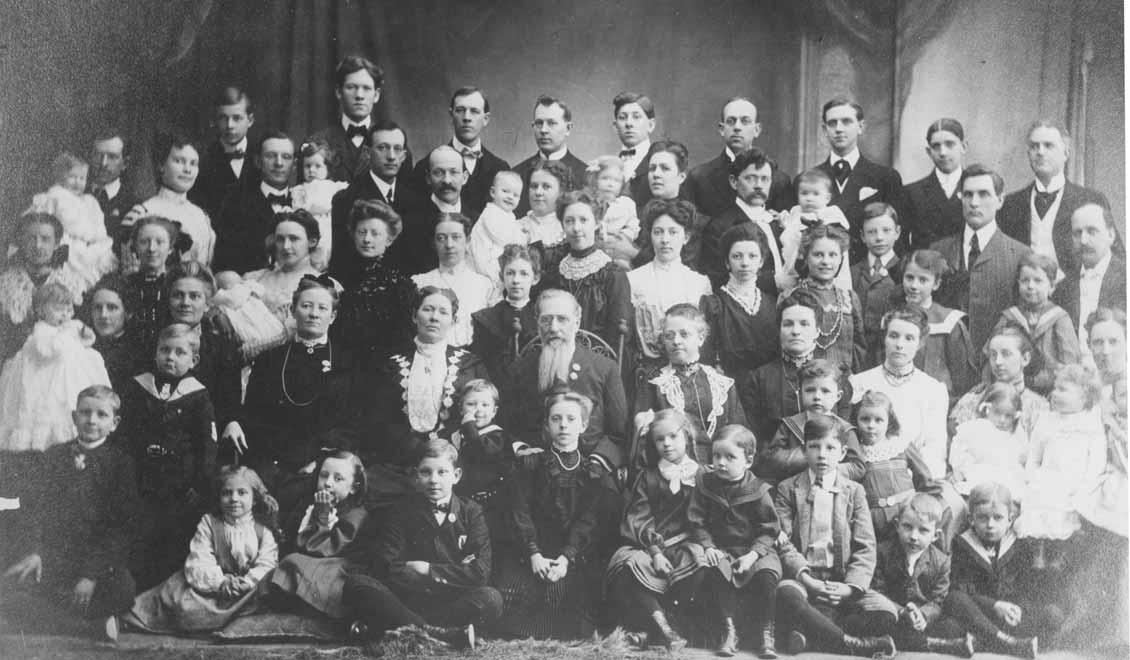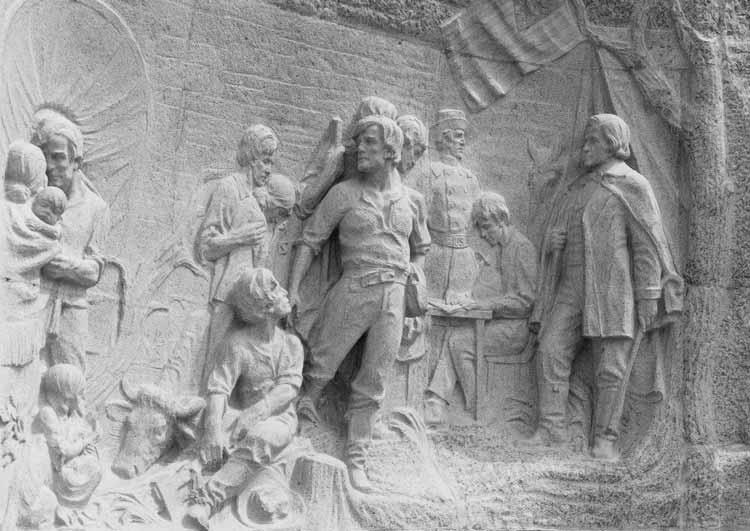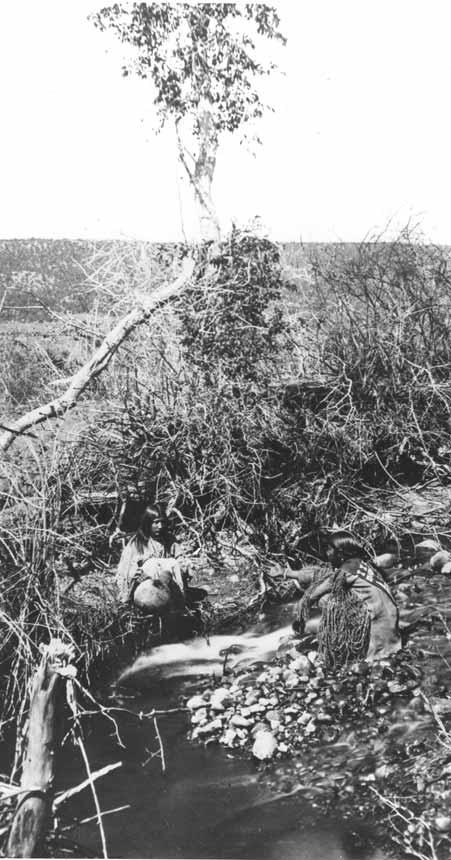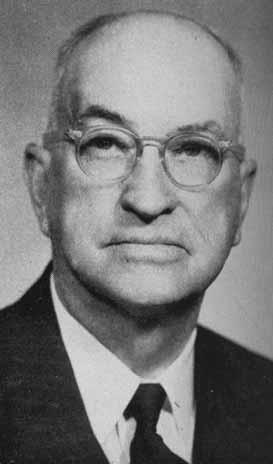
15 minute read
Book Notices
Sanpete Scenes:A Guide to Utah’s Heart
By Gary B.Peterson and Lowell C. Bennion.(Eureka,Ut.:Basin Plateau Press,2004.162 pp.Paper,$24.95.)
This delightful,fact-filled,richly illustrated,and highly popular book was first published in 1987.It received an Award of Merit from the American Association for State and Local History and the J.B.Jackson Prize from the Association of American Geographers for the finest work in popular geography in North America in 1989.The 1987 edition was reviewed in the Winter 1989 issue of Utah Historical Quarterly.This 2004 edition includes minor corrections to the original seven chapters and a new eighteen-page chapter “Recent Changes in Utah’s Bypassed Heart.”
Radical Origins:Early Mormon Converts and Their Colonial Ancestors
By Val D.Rust.(Urbana and Chicago:University of Illinois Press,2004.xiii + 253 pp. $35.00.)
This book examines the lives of 583 converts to The Church of Jesus Christ of Latter-day Saints during the formative years 1830 to 1835.These individuals represent about 40 percent of the church’s early membership. The study reveals that most of the early LDS converts were sixth or seventh generation Americans; their ancestors were among the first generation of Europeans to live in New England; most of the ancestors lived in the more religiously radical towns of New England; many of their ancestors had been ostracized and expelled from Massachusetts Colony; and a considerable number whipped, mutilated, and hanged for their religious views. Under these circumstances, the author discusses the nature of the radical religious experience in New England and addresses the question of whether or not the radical views of ancestors predisposed their descendents to embrace a new American religion—Mormonism.
Mormons at the Missouri:Winter Quarters,1846-1852
By Richard E.Bennett. (Norman:University of Oklahoma Press,2004.xi + 357 pp.Paper,$19.95.)
First published in 1987, Mormons at the Missouri is an important study of the Mormon sojourn in Winter Quarters,Nebraska,during the critical six year period following the exodus from Nauvoo,Illinois,in the aftermath of the assassination of Joseph Smith,Jr.The establishment of Winter Quarters was a prelude to the extensive Mormon colonization of the Intermountain West beginning in 1847 and demonstrated the leadership that Brigham Young would exert as leader of the Mormon faith.Winter Quarters played a vital role in the Mormon story as the interim headquarters for Mormons from 1846 to 1848 during the period of transition from Illinois to the Great Basin.
Neglected for too long by historians,Winter Quarters,Bennett argues,is essential to understanding the nineteenth century Mormon experience.“Here revelations were proclaimed,apostolic supremacy and succession pronounced and made firm,and a battalion raised amid formidable obstacles and opposing attitudes.At Winter Quarters women exercised the priesthood,new patterns of worship were implemented,and plans for the great trek west were solidified.Polygamy and the law of adoption and other new and barely tested doctrines were practiced in the open.And here faith deepened while apostasy flourished”(6).
The book’s twelve chapters examine the abandonment of Nauvoo,the trek across Iowa,the decision to spend the winter of 1846-47 at Winter Quarters,the establishment of the settlement,relations with Indians and Indian agents,preparations for the move west,sickness and death,and other aspects of the economic, social,religious,and community life for the several thousand Mormon emigrants who found refuge in Winter Quarters.
Great Basin Kingdom:An Economic History of the Latter-day Saints,1830-1900
By Leonard J.Arrington.(new ed.;Urbana and Chicago:University of Illinois Press,2005. xxxix + 534 pp.Paper,$36.00.)
Since its first appearance nearly a half century ago in 1958, Great Basin Kingdom, Leonard Arrington’s magnum opus, has been published in editions by four prestigious academic presses—Harvard University Press, University of Nebraska Press, University of Utah Press, and, the latest, University of Illinois Press. While Arrington’s text remains unchanged from earlier editions, the Illinois edition includes an informative introduction by Ronald W. Walker that outlines the influences on Leonard Arrington in writing Great Basin Kingdom, the story of its writing and publication, and an assessment of its importance in Utah and Mormon historical writing.
Bees in America:How the Honey Bee Shaped A Nation
By Tammy Horn. (Lexington:The University Press of Kentucky,2005.xvi + 333 pp.Cloth,$27.50.)
The bee is more than a source of beeswax and honey.In her book, Tammy Horn,a beekeeper,shows how bees,since their arrival in America,have affected people,like their impact on native peoples and their use by colonists. Horn’s book,among other things,examines how and why Americans,including Mormons,have used the bee and the hive as symbols in various ways throughout the development of our nation.
Thirty Years Into Yesterday:A History of Archaeology at Grasshopper Pueblo
By Jefferson Reid and Stephanie Whittlesey.(Tucson:University of Arizona Press,2005. xx + 268 pp.Cloth,$35.00;paper,$16.95.)
Grasshopper is a five-hundred-room Mogollon pueblo located on the Fort Apache Indian Reservation in Arizona.The University of Arizona Archaeological Field School conducted fieldwork at Grasshopper for thirty years, during which time the approach to archaeological research underwent significant changes.In Thirty Years Into Yesterday,Jefferson Reid and Stephanie Whittlesey not only try to describe the lives of the prehistoric peoples who inhabited Grasshopper,but also to explain the research conducted and the various theories that sprung from the archaeological findings at Grasshopper during three decades of fieldwork at the site.
Blanket Weaving in the Southwest
By Joe Ben Wheat,edited by Ann Lane Hedlund. (Tucson:University of Arizona Press,2003.xxvi + 442 pp.Cloth,$75.00.)
This is a book for serious students of weaving in the American Southwest. The volume looks at the three main traditions of woolen weaving: Pueblo, Navajo, and Spanish American. While blankets are the primary focus, other items including breechcloths, sashes, sash belts, serapes, ponchos, ceremonial kilts, saddle cinches, and other items are included. After essays on the historical background, fibers and yarns, colors, imported fabrics, weaving systems, weave, and design, there are 191 color plates which illustrate a rich variety of woven items from the Southwest.
Navajo Weaving in the Late Twentieth Century:Kin,Community,and Collectors
By Ann Lane Hedlund.(Tucson:University of Arizona Press,2004.xv + 145 pp.Cloth, $35.00.)
Navajo Weaving in the Late Twentieth Century:Kin,Community,and Collectors showcases the work of sixty native weavers.The seventy-four color plates that are included represent a variety of styles and also differ depending on the region where they were created.Another fifty-four pictures portray the individuals,settings,locations,and scenery that help connect the reader to the Navajo weaving tradition.Ann Lane Hedlund also provides information on the creations featured in this book and an overview of the history of Navajo weaving and textile collecting.
Weaving A Legacy:Indian Baskets and the People of Owens Valley,California
By Sharon E.Dean,Peggy S.Ratcheson,Judith W.Finger,Ellen F.Daus,and Craig D. Bates.(Salt Lake City:University of Utah Press,2004.viii + 182 pp.Cloth,$55.00;Paper, $24.95.)
Weaving A Legacy describes the lives and basket making of the Paiute and Panamint Shoshone from the Owens Valley of east central California and the changes both have undergone over time.The authors tell their story not only with words,but also with a variety of pictures that,besides showing the area and its inhabitants,show a variety of unique baskets that have been carefully crafted.
On the Upper Missouri:The Journal of Rudolph Friedrich Kurz,1851-1852
Edited and abridged by Carla Kelly.(Norman:University of Oklahoma Press,2005. xxv + 318 pp.Paper,$21.95.)
Rudolph Friedrich Kurz was a Swiss artist who was fascinated with American Indians.He came to the United States in order to observe and paint them in his art. To make ends meet, he worked for the American Fur Company at its headquarters at Fort Union on the upper Missouri River near the present-day border of North Dakota and Montana. On the Upper Missouri consists of selections from Kurz’s journal. The Smithsonian Institution’s Bureau of American Ethnology acquired a typed manuscript of the Kurz journal for 18461852,which was translated into English and then published in 1937.Carla Kelly took the excerpts from the years 1851-1852 from the 1937 translation for publication in this volume. Kelly has retained the most relevant and interesting parts of his journal that illustrate the changes that were happening in the west almost a decade before the Civil War. This book also contains a number of sketches by Kurz, including Fort Berthold, Fort Union, and Indians from various tribes.
Finding Sand Creek:History,Archeology,and the 1864 Massacre Site
A.Greene and Douglas D.Scott.(Norman:University of Oklahoma Press,2004.xxvi +241 pp.Cloth,$24.95.)
In 1864 one hundred fifty Indian men,women,and children were killed when more than seven hundred U.S.volunteer troops under the command of Colonel John M.Chivington attacked the Southern Cheyenne and Arapaho village located along Sand Creek in southeastern Colorado Territory.In 1998 the United States Congress directed the National Park Service to begin a research program to verify the massacre location. Finding Sand Creek:History,Archeology, and the 1864 Massacre Site describes the project to locate the exact site of the massacre.Experts used oral histories,written records,and archaeological fieldwork in an effective interdisciplinary project that identified the site and led to the establishment of the Sand Creek Massacre National Historic Site in 2000.
Bound for Montana:Diaries from the Bozeman Trail Edited by Susan Badger Doyle.
(Helena:Montana Historical Society Press,2004.xi + 260 pp.Paper,$19.95.)
Bound for Montana:Diaries from the Bozeman Trail,contains seven diaries taken from Journeys to the Land of Gold:Emigrant Diaries from the Bozeman Trail,1863-1866.The diaries were written by a diverse group of people,including a store clerk and a prospector.The diaries are included with their original formatting intact.The editor provides extensive notes with each diary and information about the authors and their fates after they reached their destination.
A Tenderfoot in Montana: Reminiscences of the Gold Rush,the Vigilantes,and the Birth of Montana Territory
By Francis M.Thompson and edited by Kenneth N.Owens. (Helena:Montana Historical Society Press,2004.xi + 292 pp.Paper,$14.95.)
After deciding not to join the military on the Union side during the Civil War, Frank Thompson set out west. He searched for gold, served on Montana’s first territorial legislature, and befriended both criminals and vigilantes. He was present when vigilantes brought sheriff Henry Plummer to justice. A Tenderfoot in Montana, edited by Kenneth M. Owens, is Thompson’s own account of his adventures.
Indian Views of the Custer Fight: A Source Book
Compiled and edited by Richard G.Hardorff.(Norman:University of Oklahoma Press,2005.237 pp.Paper,$14.95.)
The Battle of the Little Bighorn,which ended in the overwhelming defeat of Lt.Col.George Armstrong Custer’s forces on June 25,1876,has found its place in American lore as “Custer’s Last Stand.”It has been the subject of countless paintings,movies,and books.Custer has been hailed as a hero and the Indian side of the story has often been sadly neglected. Indian Views of the Custer Fight is a collection of primary sources,and the third installment in a series centered on Indian testimony about the battle that took place at Greasy Grass.It includes first-hand accounts of the battle given by Indians such as Crazy Horse and it also contains notes by the editor that provide additional information.
The Custer Reader
Edited by Paul Andrew Hutton.(Norman:University of Oklahoma Press,2004.xiv + 585 pp.Paper,$24.95.)
The Custer Reader is a treasure trove of information on George Armstrong Custer.Besides containing essays on Custer written by academics,it also contains a variety of first-person narratives,including some composed by Custer himself.In addition, The Custer Reader contains a series of photographic essays,which chronicle George Armstrong Custer’s service in the Civil War,his confrontations with Native Americans,and finally,how he has been portrayed since his death.
Searching for Yellowstone:Ecology and Wonder in the Last Wilderness
By Paul Schullery.(Helena:Montana Historical Society Press,2004.xx + 338 pp.Paper,$19.95.)
Yellowstone National Park was established on March 1,1872,and since that time has been a focal point of America’s evolving conservation ethic. Paul Schullery,the author of Searching for Yellowstone:Ecology and Wonder in the Last Wilderness,knows Yellowstone intimately.His book is an insightful and sensitive account that outlines the history of a number of conservation issues in the park.It notes the changes Yellowstone has undergone over time,highlighting that the park is ever changing,that discoveries are always being made there,from the change in animal populations to the discovery of new enzymes and natural wonders.
Chiefs and Generals:Nine Men Who Shaped the American West
Edited by Richard W. Etulain and Glenda Riley.(Golden,Colorado:Fulcrum Publishing,2004.xi + 241 pp. Paper,$17.95.)
Chiefs and Generals:Nine Men Who Shaped the American West is the fifth installment in the Notable Westerners series.It is a collection of wellresearched essays on both tribal and military leaders.Besides essays on well-known men like George Custer,George Crook,Chief Joseph,and Geronimo,the collection includes essays on less known leaders including Lakota Chief Red Cloud, Apache Chief Victorio,O.O.Howard,Ranald MacKenzie,and Nelson A.Miles. The essays illustrate the complex,often volatile,relationship between Indians and whites especially well.
The Apache Indians: In Search of the Missing Tribe
By Helge Ingstad,translated by Janine K.Stenehjem.(Lincoln:University of Nebraska Press,2004.xxxix + 188 pp.Cloth, $24.95.)
Helge Ingstad studied and practiced law in his native Norway before he grew restless and set off for Canada.He became a self-taught ethnographer,historian,and explorer.In Canada he lived as a trapper for four years with the Chipewyan Indians.They told him about people from their tribe who traveled south and were never heard of again.In 1936 Ingstad arrived near the White Mountain Reservation in Arizona in search of information about the people from the North.He heard stories about the Apaches’northern origins and that another group of Apaches had fled from the reservation to live in Mexico’s Sierra Madre Mountains and set off to find them.His account was published in Norway in 1939.This translation of that account includes a preface by his daughter,who notes that her father,born in 1899 and died in 2001,had lived in three centuries.
Ojibwa Warrior: Dennis Banks and the Rise of the American Indian Movement
Banks and Richard Erdoes.(Norman:University of Oklahoma Press,2004. xii + 362 pp.Paper,$19.95.)
Ojibwa Warrior chronicles the life of Dennis Banks and traces the emergence of the American Indian Movement (AIM),which was founded in 1968.Some of the major events include the takeover of Alcatraz Island in 1969, the occupation of Mount Rushmore in 1970,the “Trail of Broken Treaties,”a march on Washington D.C.that resulted in the temporary takeover of the Bureau of Indian Affairs building in 1972,a siege at Wounded Knee in 1973,and other conflicts involving Dennis Banks and other AIM leaders.
A Vast Amount of Trouble:A History of the Spring Creek Raid
By John W.Davis. (Norman:University of Oklahoma Press,2005.x + 291 pp.Paper,$19.95.)
Conflict between cattlemen and sheepmen was a constant in most regions of the American West.One of the most violent episodes occurred on the banks of Spring Creek in north central Wyoming where three sheepmen were murdered in 1909 when cowboys raided their camp.John W.Davis is a lawyer from Wyoming.His book, A Vast Amount of Trouble:A History of the Spring Creek Raid,originally published by the University Press of Colorado in 1993,examines the events leading up to the murders,the trial that followed,and the resulting end to Wyoming’s violent range wars.
The Western Pursuit of the American Dream
By Kenneth W.Rendell.(Natick,MA: Historical Publications,2004.x + 358 pp.Cloth,$39.95.)
Kenneth W.Rendell is a dealer in historical documents and letters. This heavily illustrated volume includes examples of artwork,clothing,currency, furs,letters,historical documents,jewelry,musical instruments,vehicles,weapons and other artifacts from a multitude of sources that represent nearly two dozen themes in western history including the fur trade,Santa Fe,Indians,California,the Overland Trail,the Mormons,the California Gold Rush,cowboys,outlaws and lawmen,and the West of the twentieth century.
The Colonel and the Pacifist: Karl Bendetsen, Perry Saito, and the Incarceration of Japanese Americans during World War II
By Klancy Clark de Nevers.(Salt Lake City: University of Utah Press,2004.xv + 382 pp.Cloth,$55.00;Paper,$21.95.)
In her book, Klancy Clark de Nevers investigates the lives of two men, Karl Bendetsen and Perry Saito and issues of racism and war that were common to both. Bendetsen and Saito were from Aberdeen, Washington, and despite residing in the same hometown, their lives went in opposite directions during World War II.Karl Bendetsen, a colonel in the United States Army, was in charge of the West Coast evacuation of Japanese Americans, and Perry Saito was an evacuee who was incarcerated at the Tule Lake Relocation Camp. In The Colonel and the Pacifist, de Nevers brings together the stories of these two men in order to relate both sides of an important and controversial episode in American history.
First Sight of the Desert:Discovering the Art of Ella Peacock
By Kathryn J.Abajian. (Salt Lake City:University of Utah Press,2005.vii + 144 pp.Paper,$21.95.)
First Sight of the Desert tells the story of both Ella Peacock,a Utah artist who died in 1999,and her biographer,Kathryn J.Abajian.Born in Pennsylvania to a well-to-do Germantown family in 1906,Ella studied art and began painting in the 1920s.In 1968 she and her husband bought an adobe house in Spring City built by Danish immigrant Lauritz Larsen a century before. Abajian first met Peacock in Spring City in 1986 and in 1991 began a series of interviews with the artist.Abajian entwines the story of Ella Peacock with that of her own, providing impressionistic biographical sketches of both individuals rather than a detailed, fact filled life story of either. Each of the ten chapters is named after a painting by Ella Peacock—Mt. Peacock, Grandfather’s Portrait, The Girl in the Red Scarf, Out West, Lehi Roller Mills, The Manti Temple, Spring City Chapel, Being Demolished, The Old Homestead at Pigeon Hollow —and a reproduction of each painting is printed on the page opposite the first page of the chapter bearing its name. The final chapter and the book itself are named for one of Abajian’s favorite paintings, First Sight of the Desert, a painting that she first saw on her first meeting with Peacock and now owns.
Excavating Mormon Pasts:The New Historiography of the Last Half Century
Edited by Newell G.Bringhurst and Lavina Fielding Anderson (Salt Lake City:Greg Kofford Books,2004.xiv + 442 pp.$39.95.)
The sixteen chapters in this volume offer an overview of the historiography of Mormonism from 1950 to 2000 by a number of leading Mormon historians.Chapters of special interest to students of Utah history include,Craig L.Foster’s,“Mormonism on the Frontier:The Saints of the Great Basin;”M.Guy Bishop’s,“Mormonism in Transition,1890-1945;”Jessie L.Embry’s “The LDS Church in the United States since 1945;”along with chapters on Women’s history by Todd Compton,polygamy by Martha Sonntag Bradley,Mormon biography by Newell G.Brighhurst,and Mormon society and culture by Davis Bitton. Other chapters examine Mormon origins in New York and Ohio,the Missouri and Illinois experiences,the growth and internationalization of the Mormon church since 1945,the Community of Christ,and conflict,dissent,and schism in the early church.







